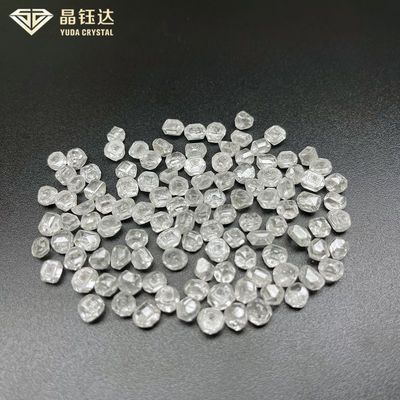D E F Color VVS-SI 1.00-2.00ct Lab Grown Rough Diamonds For Polishing Lab Diamonds
Lab Grown Rough Diamonds Description
Are the rough diamonds grown in the laboratory real diamonds?
The rough diamonds grown in the laboratory and the natural diamonds grown in the laboratory are pure carbon and have the same physical and chemical properties.
What is the difference between a lab-grown rough diamond and a natural diamond?
Because natural diamonds are formed in the natural environment, other elements are often mixed in during the process of its formation. These impurity elements change the energy band structure of the diamond, making some natural diamonds not completely transparent, but showing Out a specific color. Diamonds with different impurities have different colors. For example, some diamonds are a little pink, some are a little sky blue, and some are light yellow or golden yellow.
Both natural and laboratory-grown rough diamonds are produced with carbon components, which are transformed into scintillating cubic crystals. Although its chemical basis provides laboratories with the same optical properties as natural diamonds, the cultivation of laboratory diamonds is not inherently rare. Natural diamonds are formed by squeezing deep layers of the earth's crust. This is why all natural diamonds that will always exist are "produced" and make them rare in the world. In turn, the laboratory will grow diamonds, and the production of diamonds is unlimited.
It is difficult for ordinary people to distinguish the difference between man-made diamonds and natural diamonds with the naked eye. In fact, the difference between these two types of diamonds is so small that it is difficult to distinguish them even with scientific instruments. Under normal circumstances, X-ray fluorescence spectrometers and other equipment can be used to detect diamonds, but there is currently no fixed criterion that can distinguish man-made diamonds from natural diamonds, so this type of detection can only give some reference. opinion.
Moreover, in addition to making all kinds of diamond jewelry, diamonds can also be used to make precision instruments such as lasers and radars. Diamonds are often used even in physical research. For example, when American physicists are studying high-temperature superconducting materials recently , In order to get a pressure of several million atmospheres, two diamonds are opposed to each other to generate a huge pressure. Therefore, even if it is not used to manufacture luxury goods, artificial diamonds reduce the price of diamonds, which are also very beneficial for applications in industry and scientific research.
Parameters of Lab Grown Rough Diamonds
| Lab Grown Rough Diamonds Details |
| Brand Name |
Yuda Crystal |
| Name |
Lab Grown Rough Diamonds |
| Diamond Color |
D-F |
| Diamond Clarity |
VVS VS SI |
| Diamond Carat Weight |
1.0 - 2.0 carat |
| Diamond Cut |
Uncut |
| Technology |
HPHT |
| Size |
5.0 to 8.0mm |
| Shape |
Raw |
| Application |
For Cutting Lab Grown Loose Diamonds |
| Place Of Origin |
Zhengzhou, China |
| Delivery Time |
1 - 7 Working Days Base on Order Quantity |
| Payment Terms |
100% Payment In Advance |
| Payment Methods |
T/T, PayPal, Western Union, Bank Transfer |
| Shipping way |
DHL, FedEx, SF Express, UPS, EMS, TNT etc |
| M.O.Q |
Negotiable |
| Diamond Type |
Synthetic(lab created) |
| Location |
Zhengzhou, China |
| Treatments Applied |
None |
| Fire Dispersion |
0.044(Same as Natural Diamond) |
| Brilliance Refraction Index |
2.42(Same as Natural Diamond) |
| Relative Density |
3.52(Same as Natural Diamond) |
| Chemical Composition |
Carbon(Same as Natural Diamond) |
| Moh's Hardness |
10(Same as Natural Diamond) |
Lab Grown Rough Diamonds Introduction
Natural diamonds are created by nature and are the result of high temperature and pressure formed over billions of years. The Rough Lab Grown Diamonds are produced in the laboratory, usually in a few weeks. The chemical difference between the two is same.
So how do you distinguish between Rough Lab Grown Diamonds and natural diamonds?
There is no obvious difference between the Rough Lab Grown Diamonds and natural diamonds. Even professional gemologists need special equipment to identify them. By zooming in, professionals will be able to discern subtle contrasts in diamond inclusions grown and mined in the laboratory.
| The Difference Between Lab Diamond And Natural Diamond |
| Properties |
Earth Mined |
Lab Created |
| Guaranteed Conflict-Free |
No |
Yes |
| Hardness (MOHS) |
10 |
10 |
| SP3 Carbon Diamond Bonds (%) |
100% |
100% |
| Internal Crystal Structure |
Face-Centered Cubic |
Face-Centered Cubic |
| Hardness Comparable |
2.42 |
2.42 |
| Relative Diversity |
3.52 |
3.52 |
| Color Diffusion |
0.044 |
0.044 |
| Color |
Various Grades |
K to D grades |
| Price |
$$$$$ |
$$$
|
Lab Grown Rough Diamonds Details


 Your message must be between 20-3,000 characters!
Your message must be between 20-3,000 characters! Please check your E-mail!
Please check your E-mail!  Your message must be between 20-3,000 characters!
Your message must be between 20-3,000 characters! Please check your E-mail!
Please check your E-mail! 






